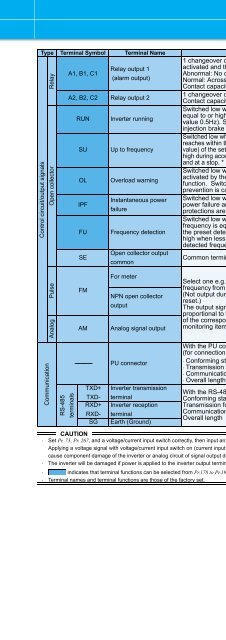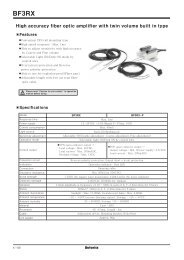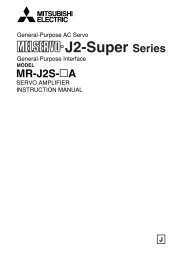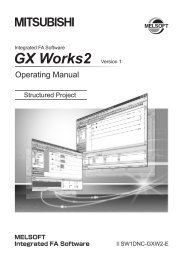FR-A701 catalog - Mitsubishi Electric Australia
FR-A701 catalog - Mitsubishi Electric Australia
FR-A701 catalog - Mitsubishi Electric Australia
Create successful ePaper yourself
Turn your PDF publications into a flip-book with our unique Google optimized e-Paper software.
Type Terminal Symbol Terminal Name DescriptionRelayControl circuit/output signalsOpen collectorCommunicationPulseTerminal ConnectionDiagramTerminal SpecificationExplanationInquiryAnalogFeaturesStandardSpecificationsOutlineDimensionDrawingsParameterListProtectiveFunctionsOptionsInstructionsWarrantyRS-485terminalsA1, B1, C1Relay output 1(alarm output)A2, B2, C2 Relay output 2RUNSUOLIPFFUSEFMAMInverter runningUp to frequencyOverload warningInstantaneous powerfailureFrequency detectionOpen collector outputcommonFor meterNPN open collectoroutputAnalog signal output----------------- PU connectorTXD+TXD-RXD+RXD-SGInverter transmissionterminalInverter receptionterminalEarth (Ground)1 changeover contact output indicates that the inverter protective function hasactivated and the output stopped.Abnormal: No conduction across B-C (Across A-C Continuity),Normal: Across B-C Continuity (No conduction across A-C)Contact capacity: 230VAC 0.3A (Power factor = 0.4) 30VDC 0.3A1 changeover contact outputContact capacity: 230VAC 0.3A (Power factor = 0.4) 30VDC 0.3ASwitched low when the inverter output frequency isequal to or higher than the starting frequency (initialvalue 0.5Hz). Switched high during stop or DCinjection brake operation. *Switched low when the output frequencyreaches within the range of ±10% (initialvalue) of the set frequency. Switchedhigh during acceleration/decelerationand at a stop. *Switched low when stall prevention isactivated by the stall preventionfunction. Switched high when stallprevention is cancelled. *Switched low when an instantaneouspower failure and under voltageprotections are activated. *Switched low when the inverter outputfrequency is equal to or higher thanthe preset detected frequency andhigh when less than the presetdetected frequency. *Alarm code(4bit) outputCommon terminal for terminals RUN, SU, OL, IPF, FUSelect one e.g. outputfrequency from monitor items.(Not output during inverterreset.)The output signal isproportional to the magnitudeof the correspondingmonitoring item.Permissible load 24VDC(27VDC maximum) 0.1A(A voltage drop is 2.8Vmaximum when the signal ison.)* Low indicates that the opencollector output transistor is on(conducts).High indicates that the transistoris off (does not conduct).Output item: Output frequency (initial setting)Permissible load current 2mA1440pulses/s at 60HzSignals can be output from the open collectorterminals by setting Pr. 291.(Maximum output pulse: 50kpulses/sPermissible load current : 80mA)Output item: Output frequency (initial setting)Output signal 0 to 10VDCPermissible load current 1mA(load impedance 10kΩ or more) Resolution 8 bitWith the PU connector, communication can be made through RS-485.(for connection on a 1:1 basis only)⋅ Conforming standard : EIA-485 (RS-485)⋅ Transmission format : Multidrop link⋅ Communication speed : 4800 to 38400bps⋅ Overall length: 500mWith the RS-485 terminals, communication can be made through RS-485.Conforming standard : EIA-485 (RS-485)Transmission format : Multidrop linkCommunication speed : 300 to 38400bpsOverall length: 500mCAUTION⋅ Set Pr. 73, Pr. 267, and a voltage/current input switch correctly, then input an analog signal in accordance with the setting.Applying a voltage signal with voltage/current input switch on (current input is selected) or a current signal with switch off (voltage input is selected) couldcause component damage of the inverter or analog circuit of signal output devices.⋅ The inverter will be damaged if power is applied to the inverter output terminals (U, V, W). Never perform such wiring.⋅ indicates that terminal functions can be selected from Pr.178 to Pr.196 (I/O terminal function selection).⋅ Terminal names and terminal functions are those of the factory set.12
















